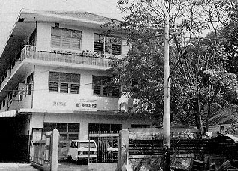 BANDA ACEH, Dec 15 (Reuters) - One moment Sartinah Fatar is painting her lovely new traditional Acehnese house, chattering happily to her husband. The next she's in tears recalling the day the sea roared in and snatched away her mother and two children.
BANDA ACEH, Dec 15 (Reuters) - One moment Sartinah Fatar is painting her lovely new traditional Acehnese house, chattering happily to her husband. The next she's in tears recalling the day the sea roared in and snatched away her mother and two children.Remember. Rebuild. It's the slogan of the Indonesian reconstruction agency, set up after the Dec. 26 tsunami killed 231,452 people around the Indian Ocean rim, most of them in Aceh.
Sartinah and hundreds of thousands of other tsunami survivors are doing plenty of both as the anniversary of one of nature's most ferocious episodes approaches on Dec. 26.
Sartinah's family is one of the lucky few that have a new home. More than 1.5 million people are still living in tattered tent camps, military-style barracks or crammed in with relatives in Indonesia, India, Sri Lanka and Thailand.
Even the dead cry out for better shelter.
Near Sartinah's house in Kampong Java, a fishing community in Banda Aceh, is a crude hand-painted sign. "This is a mass grave," it says. "Don't throw garbage on our mortal remains and soul. Allah has called us. Let us rest in peace."
Indeed, for two miles into Banda Aceh the tsunami erased everything, leaving a bleak landscape of cement and tile foundations that resemble big burial slabs in a vast graveyard.
A quarter of Kampong Java's population of 5,000 survived the 9.15 earthquake, the strongest in 40 years, and the series of tsunami waves it spawned.
ASKING FORGIVENESS
Sartinah's family was eating breakfast when the quake rattled the dishes off the table. They ran outside, joining others who were racing in from the beach shouting "the water is coming".
She ran with her husband to the elementary school next door, her 8-year-old daughter close on her heels and her 18-year-old son helping his frail grandmother.
Sartinah was about to haul herself onto the roof of the school when the waves, taller than the palm trees in the yard and travelling faster than a train, slammed into her.
She never saw her daughter, son and mother again.
"I was hanging onto the roof and thinking I never had a chance to ask for my mother's forgiveness," Sartinah said, the tears flowing down her cheeks. "As a Muslim you have to ask forgiveness. If your mother doesn't forgive you, you can't go to heaven."
The disaster of biblical proportions drew a veritable Noah's Ark of faith-based groups to the tsunami region, including Muslim Aid, which is building 172 traditional Acehnese homes in Kampong Java. Some survivors wondered why God had unleased such terrible fury on their communities
Overall, the international community raised more than $11 billion, "the most generous and most immediately funded international emergency relief effort ever", U.N. emergency coordinator Jan Egeland said.
Muslim Aid took its design for panggung houses to the surviving residents of Kampong Java and allowed them to customise the design to their own needs,
The result was a 48-sq-metre (516 sq ft) three-room, quake-resistant home on thick timber stilts, with concrete walls, a corrugated roof and front verandah.
"All the homes look different, so it doesn't look like a Council housing project," said H. Fadlullah Wilmot, Muslim Aid's country director in Indonesia.
The donor community has pushed for community involvement in the $10 billion reconstruction effort in the main tsunami affected countries, one of the reasons home rebuilding has gone so slowly, Oxfam International said in a report on Wednesday.
"'Do it quick, but do it with communities' was the motto when working on shelter throughout the tsunami zone," it said.
Bureaucratic problems in acquiring land, unclear government policies and aid agencies' lack of expertise in building shelters also contributed to delays.
WRECKAGE IN MINDS
Only 15 percent of the 308,000 homes that need to be built in tsunami affected countries have been completed or under construction, according to government data.
While the physical debris has largely been cleared from coastal communities, health workers worry about the wreckage in peoples' minds.
The tsunami pulverised entire communities and slaughtered its inhabitants. The monster waves left thousands of orphans, "bachelor towns", women bereft of children and the compounded grief from multiple deaths in families in its awful wake.
A year ago, women outnumbered men in Aceh. A long-running separatist rebellion had thinned the ranks of possible grooms. but the tsunami killed up to 75 percent of the women in coastal communities of Indonesia, India and Sri Lanka and now thousands of widowers are looking for brides.
An Oxfam report in March said women were slowed by the children they carried and were less likely to know how to swim. Men, on the other hand, were out on boats, running errands, or working further inland in fields or hills.
Some women still cling to an irrational hope their children are alive; others are undergoing reversals of tubal ligations to try and have babies again.
Aid groups such as New York-based International Rescue Committee have set up "child friendly spaces" to help heal the psychic wounds of the young and most vulnerable.
About a fifth of Aceh's children are suffering at least slight trauma requiring intervention, said Sonny Irwan, an IRC programme coordinator for Cot village down the coast from Kampong Java. There, kindergarten children draw pictures, play on swings -- and sing songs with incredible gusto.
Through these forms of expression they can draw on their own inner strengths and heal, he said
"In the beginning, they just drew pictures of the tsunami," Irwan said. "Now the pictures are of normal families with the sun and the sky."


No comments:
Post a Comment